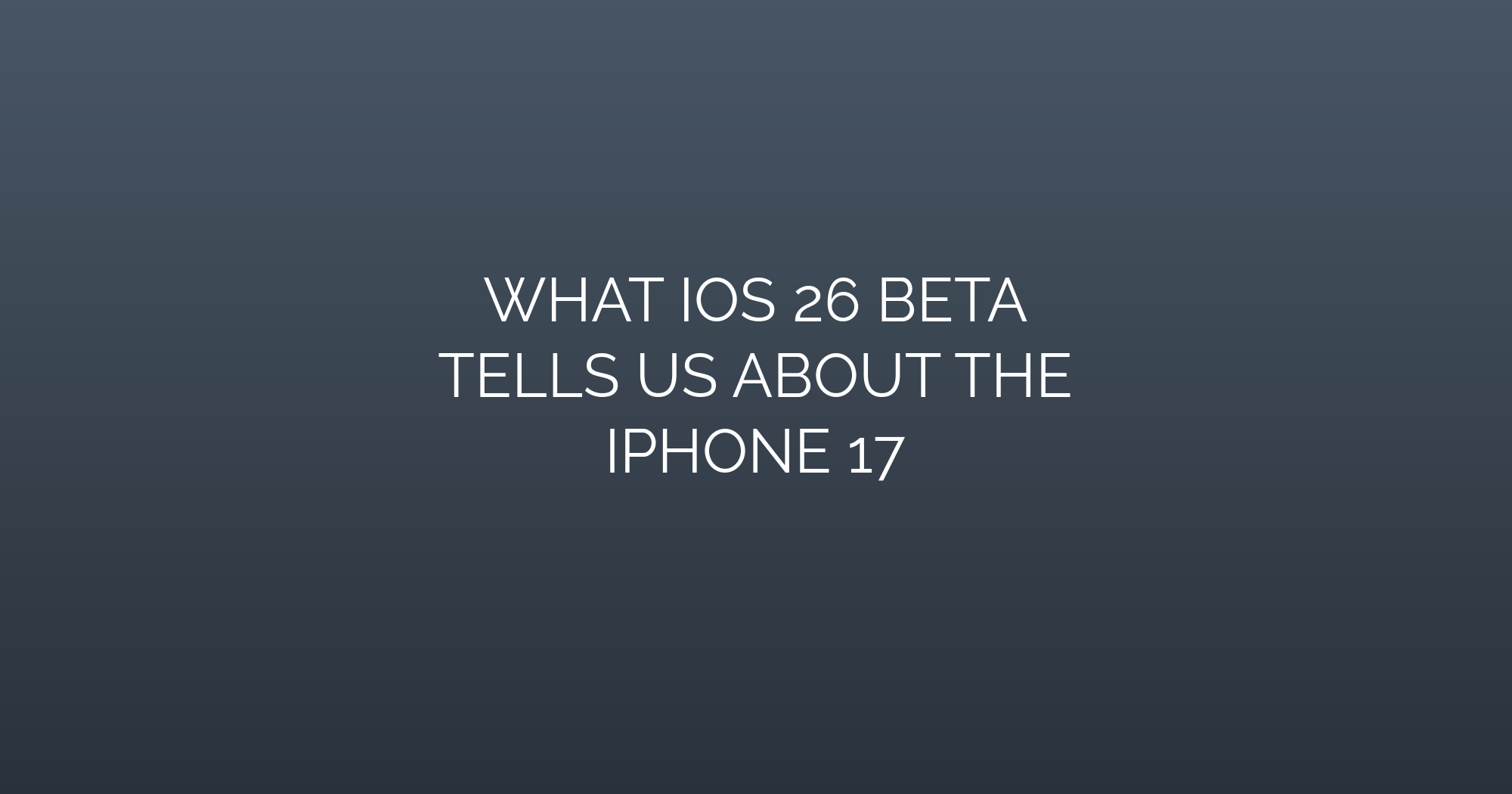What iOS 26 Beta Tells Us About the iPhone 17
The annual release of Apple’s iOS beta software offers more than a glimpse of upcoming software features—it often harbors subtle hints about the nextgeneration iPhone hardware. With iOS 26 now in the hands of developers, the beta reveals intriguing possibilities for the iPhone 17 series. By analyzing buried code, experimental flags, and feature dependencies, we can piece together a speculative but informed picture of Apple’s vision for its 2025 flagship.
The Critical Role of Beta Software in Apple’s Ecosystem Apple’s iOS betas are more than feature tests. They are tightly integrated proofsofconcept for future hardware. Features requiring specific sensors, chips, or displays appear in beta software long before the supporting hardware ships, giving developers time to adapt. In iOS 26, several underthehood changes demand hardware that current iPhones lack, pointing directly to the iPhone 17’s capabilities. These clues, combined with Apple’s historical patterns, suggest profound advancements in AI, camera systems, and display technology.
Section 1: AI and Machine Learning: The Engine of Evolution
iOS 26 introduces aggressive new machine learning frameworks. Code snippets reveal ondevice language models that process complex queries without cloud dependency. Key findings include:
- <strong>Siri Unleashed:</strong> Siri handles realtime contextual awareness in the beta, executing multistep tasks like summarizing emails while crossreferencing calendar invites. This demands neural engines <em>far</em> faster than the A17 Pro.
- <strong>Generative Media Tools:</strong> Native apps now support ondevice image/video synthesis. A hidden "Generative Visual Engine" option in Xcode toolchains fails to initialize on current iPhones due to insufficient RAM bandwidth.
- <strong>Advanced Predictive Text:</strong> Keyboard predictions suggest entire paragraphs in Messages and Notes, requiring realtime transformer model inference.
These features signal Apple’s plan for the iPhone 17 Pro models to deploy an A19 Pro chip with a substantially upgraded Neural Processing Unit (NPU). Expect triple the machine learning cores and a unified memory architecture to support large language model (LLM) workloads.
Section 2: Camera System: Computational Leap
The iOS 26 beta includes Camera app strings referencing hardware unavailable on iPhone 15/16 series. Evidence suggests:
- <strong>Periscope Zoom for All Pro Models:</strong> Code mentions a "folded_telephoto_main" system. This aligns with rumors of <em>both</em> iPhone 17 Pro models upgrading to periscopic telephoto lenses, enabling >10x optical zoom.
- <strong>48MP UltraWide Lens:</strong> Asset catalogs uncover highresolution ultrawide image processing modes unsupported by current 12MP sensors. This points to a sensor upgrade across the lineup.
- <strong>Enhanced Computational HDR:</strong> New bracketing algorithms capture 15+ frames at speeds impossible for existing iPhones. The iPhone 17’s chip must prioritize image signal processor (ISP) throughput gains.
These additions confirm Apple’s strategy: pairing premium lenses with software that maximizes sensor data. The iPhone 17’s photography experience will likely redefine smartphone lowlight performance and optical range.
Section 3: Brighter and Faster Displays
iOS 26’s UI layers hint at nextgen display capabilities. Export artist assets support rendering modes rated beyond today’s iPhone displays:
- <strong>3,500nit Peak Brightness:</strong> Developer flags enable "SUPER_PEAK_BRIGHTNESS" profiles for HDR playback—far exceeding the iPhone 16 Pro’s 2,000 nits.
- <strong>ProMotion 2.0:</strong> References to 1160Hz adaptive refresh rates betray plans for smoother scrolling and power savings via wider LTPO adjustment range.
- <strong>AlwaysOn Display (AOD) Expansion:</strong> The beta’s "Persistent Display Mode" includes settings for thirdparty widgets, indicating richer interactivity requiring OLED panels with microlens arrays for reduced power draw.
The iPhone 17 Pro will likely use Samsung’s M14 OLED tech with higher efficiency and brightness reserves. Combined with faster refresh flexibility, this makes AOD more functional without sacrificing battery life.
Section 4: Battery and Thermal Management
iOS 26 actively stresses power and thermal systems. New features include:
- <strong>Predictive Power Allocation:</strong> Machine learning schedules heavy tasks (e.g., backups) for offpeak hours using AIbased usage forecasting.
- <strong>Enhanced Thermal Tokens:</strong> Debug logs show granular thermal status tiers like "SUSTAINED_PERFORMANCE_MODE," implying hardware must dissipate more heat during Extended Reality (XR) tasks.
- <strong>Battery Health Model Overhaul:</strong> Fresh "Cathode Aging Simulator" tools correlate charging patterns to degradation across varying battery types.
This necessitates iPhone 17 hardware innovations:
- Larger vapor chambers or graphitebased thermal interfaces to handle sustained computing loads.
- Higherdensity batteries in tandem with efficiency gains—think 20hour screenon time targets.
Section 5: Connectivity: 5GAdvanced and WiFi 7
iOS 26 features numerous cellular framework upgrades tied to unannounced modems:
- <strong>5GAdvanced Support:</strong> CoreTelephony APIs reference 3GPP Release 18 features like "Dynamic Spectrum Sharing" and "Sub1GHz carrier aggregation"—declarations of X75 modem integration for faster 5G in congested areas.
- <strong>WiFi 7 Finalization:</strong> Network stack flags enable the full 320MHz channel bandwidth and MultiLink Operation critical to Apple’s upcoming routers and AR headsets.
The iPhone 17 will be Apple’s first to leverage Qualcomm’s Snapdragon X75 modem, coupled with WiFi 7 chips offering 40Gbps speeds. Expect reliability boosts in dense urban/international travel scenarios.
Conclusion: The iPhone 17 as a Computational Powerhouse
The iOS 26 beta paints a cohesive portrait of the iPhone 17 as Apple’s most ambitious convergence of silicon, AI, and physical hardware innovation. Key predictions include:
1. Revolutionary AI: Ondevice LLMs enabled by NPUfocused A19 chips. 2. Imaging Leadership: Periscopetier optical zoom for both Pro models and sensor upgrades. 3. Brighter, Smarter Displays: 3,500nit peak brightness with adaptive 160Hz ProMotion. 4. Tougher Thermal Designs: Hardware ready for sustained XR and ML workloads. 5. Faster Networking: 5GAdvanced and WiFi 7 for seamless connectivity.
While Apple remains notoriously secretive, iOS 26’s foundations make one thing undeniable: The iPhone 17 series isn’t just iterative—it’s engineered for a fundamental leap in performance and intelligence. Stay tuned for WWDC 2025, where Apple’s vision for iOS 26 will pioneer its next hardware revolution.

